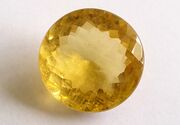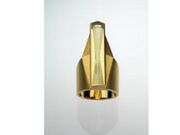Difference between revisions of "Heliodor"
Jump to navigation
Jump to search

m (Text replace - "== Authority ==" to "== Sources Checked for Data in Record ==") |
|||
| (3 intermediate revisions by the same user not shown) | |||
| Line 1: | Line 1: | ||
| + | [[File:Yellow beryl MFA 2012.842.jpg|thumb| Ring with yellow beryl<br>MFA# 2012.842]] | ||
== Description == | == Description == | ||
A golden yellow [[beryl]] stone most commonly found in southwest Africa. Heliodor has been used for Roman intaglios and [[gemstone|gemstones]]. | A golden yellow [[beryl]] stone most commonly found in southwest Africa. Heliodor has been used for Roman intaglios and [[gemstone|gemstones]]. | ||
| − | + | [[File:Heliodor-G-EmpireTheWorldOfGems.jpg|thumb|Golden beryl from [http://www.g-empire.de Empire of the World of Gems]]] | |
== Synonyms and Related Terms == | == Synonyms and Related Terms == | ||
| − | Heliodor (Deut.) | + | golden beryl; yellow beryl; Heliodor (Deut.) |
| − | |||
| − | |||
| − | + | == Physical and Chemical Properties == | |
| − | + | * Hexagonal crystal system. Crystals are generally flawless | |
| + | * Fracture = conchoidal | ||
| + | * Luster = vitreous | ||
| + | * Fluorescence = generally inert | ||
| + | * Pleochroism = weak; greenish yellow and yellow or two shades of yellow | ||
| + | * May contain inclusions | ||
{| class="wikitable" | {| class="wikitable" | ||
| Line 19: | Line 23: | ||
|- | |- | ||
! scope="row"| Density | ! scope="row"| Density | ||
| − | | 2. | + | | 2.72 g/ml |
|- | |- | ||
! scope="row"| Refractive Index | ! scope="row"| Refractive Index | ||
| − | | 1. | + | | 1.577 - 1.583 |
| + | |- | ||
| + | ! scope="row"| Birefringence | ||
| + | | 0.005 - 0.009 | ||
|} | |} | ||
| Line 29: | Line 36: | ||
[[media:download_file_454.pdf|Properties of Common Gemstones]] | [[media:download_file_454.pdf|Properties of Common Gemstones]] | ||
| − | + | ==Resources and Citations== | |
| − | + | * Gem Identification Lab Manual, Gemological Institute of America, 2016. | |
| − | == | + | * Mineralogy Database: [http://www.webmineral.com/data/Beryl.shtml Beryl] |
| − | |||
* Jack Odgen, ''Jewellery of the Ancient World'', Rizzoli International Publications Inc., New York City, 1982 | * Jack Odgen, ''Jewellery of the Ancient World'', Rizzoli International Publications Inc., New York City, 1982 | ||
| − | + | * Wikipedia: [https://en.wikipedia.org/wiki/Beryl Beryl] (Accessed Oct. 18, 2005 and Dec 2022) | |
* Thomas Gregory, ''The Condensed Chemical Dictionary'', Reinhold Publishing, New York, 3rd ed., 1942 | * Thomas Gregory, ''The Condensed Chemical Dictionary'', Reinhold Publishing, New York, 3rd ed., 1942 | ||
| − | |||
* G.S.Brady, ''Materials Handbook'', McGraw-Hill Book Co., New York, 1971 Comment: p. 101 | * G.S.Brady, ''Materials Handbook'', McGraw-Hill Book Co., New York, 1971 Comment: p. 101 | ||
Latest revision as of 14:27, 21 December 2022
Description
A golden yellow Beryl stone most commonly found in southwest Africa. Heliodor has been used for Roman intaglios and gemstones.

Golden beryl from Empire of the World of Gems
Synonyms and Related Terms
golden beryl; yellow beryl; Heliodor (Deut.)
Physical and Chemical Properties
- Hexagonal crystal system. Crystals are generally flawless
- Fracture = conchoidal
- Luster = vitreous
- Fluorescence = generally inert
- Pleochroism = weak; greenish yellow and yellow or two shades of yellow
- May contain inclusions
| Mohs Hardness | 7.5-8.0 |
|---|---|
| Density | 2.72 g/ml |
| Refractive Index | 1.577 - 1.583 |
| Birefringence | 0.005 - 0.009 |
Comparisons
Properties of Common Gemstones
Resources and Citations
- Gem Identification Lab Manual, Gemological Institute of America, 2016.
- Mineralogy Database: Beryl
- Jack Odgen, Jewellery of the Ancient World, Rizzoli International Publications Inc., New York City, 1982
- Wikipedia: Beryl (Accessed Oct. 18, 2005 and Dec 2022)
- Thomas Gregory, The Condensed Chemical Dictionary, Reinhold Publishing, New York, 3rd ed., 1942
- G.S.Brady, Materials Handbook, McGraw-Hill Book Co., New York, 1971 Comment: p. 101
